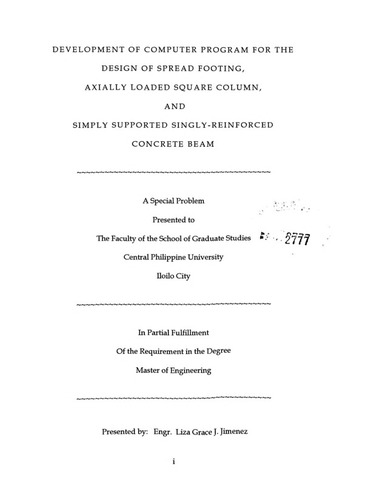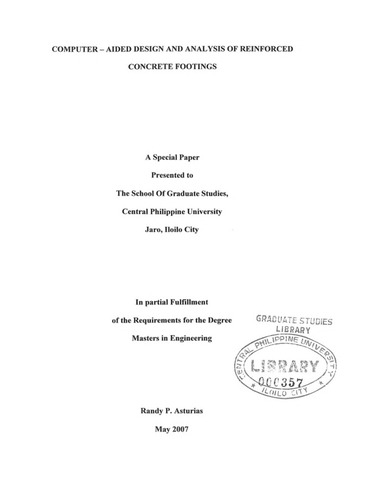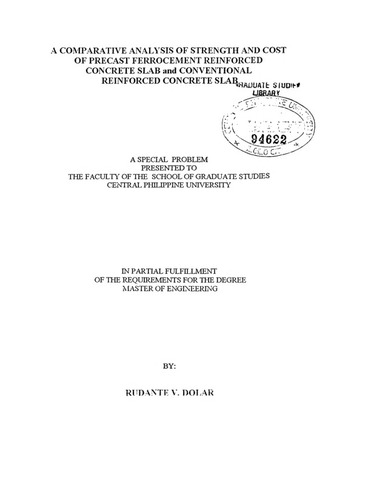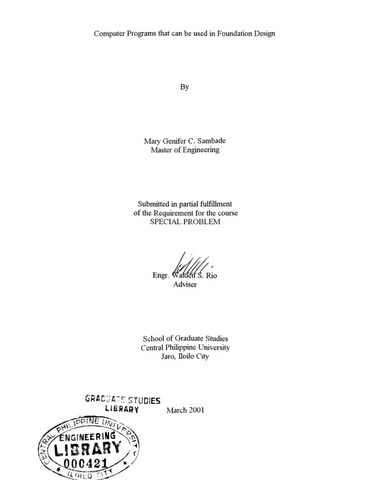Development of computer program for the design of spread footing, axially loaded square column, and simply supported singly-reinforced concrete beam

Page views
929Petsa
2001May-akda
Tagapayo ng Tesis
Tagapangulo ng Panel ng Depensa
Magbahagi
Metadata
Ipakita ang buong tala ng item
Abstract
The special project shall develop a program that would design commonly used reinforced concrete structures such as simple beam, column and isolated foundation footings. The language of programming to be used shall be Visual Basic.
The program will be structured in a way that would simplify the tremendous procedures in designing and undergoing through the lengthy formula being used. One will be able to acquire the needed results by simply inputting the known parameters and the given data for the structure. Moreover, it would increase the level of accuracy by eliminating possible errors of manual computation and at the same time acquire speed in doing the design.
The reinforced concrete structures to be designed will meet certain limitations that will be discussed later in the proceeding chapters. Among those are the available bar sizes, types of loading and etc. The design shall also conform to the ACI Code. The Method that will be used in the design shall be the ultimate Strength Design or commonly known as the Strength Design Method.
The commonly known parameters in the design for input would be the loading, value of concrete yield strength fy, compressive strength of concrete fc', and the allowable soil bearing capacity qa for footing design. As an output, the program will design the dimension of the specific structure as to its width and depth, specify the needed number and size of steel reinforcements, and the minimum spacing of stirrups.
The manual design of the different concrete structures shall be illustrated in this project while a hard copy of the program shall be printed out for reader's reference. It shall then be used for purpose of comparison as to their accuracy. Moreover, a stored program in a disk shall be made available for program test and evaluation and a flow chart of the program shall also be illustrated.
Paglalarawan
Abstract only
Mungkahing Sipi
Jimenez, L. G. J. (2001). Development of computer program for the design of spread footing, axially loaded square column, and simply supported singly-reinforced concrete beam (Unpublished Master's special paper). Central Philippine University, Jaro, Iloilo City.
Uri
Special paperMga Paksa
Concrete  ; Reinforced concrete
; Reinforced concrete  ; Reinforced concrete construction
; Reinforced concrete construction  ; Reinforced concrete--Design and construction
; Reinforced concrete--Design and construction  ; Reinforced concrete--Design
; Reinforced concrete--Design  ; Concrete beams
; Concrete beams  ; Reinforced concrete--Design--Computer programs
; Reinforced concrete--Design--Computer programs  ; Columns, Concrete
; Columns, Concrete  ; Concrete footings
; Concrete footings  ; Concrete beams--Design--Computer programs
; Concrete beams--Design--Computer programs  ; Concrete footings--Design--Computer programs
; Concrete footings--Design--Computer programs  ; Columns, Concrete--Design--Computer programs
; Columns, Concrete--Design--Computer programs  ; Visual Basic (Computer program language)
; Visual Basic (Computer program language) 
Kagawaran
College of EngineeringDegree
Master of EngineeringLokasyon ng Istante
GSL 620.0072 J564
Pisikal na paglalarawan
ii, 67 leaves
Collections
Mga parehong item
Ipinapakita ang mga item na nauugnay sa pamagat, may-akda, tagalikha at paksa.
-
Computer-aided design and analysis of reinforced concrete footings
Asturias, Randy P. (2007)The primary objective of this study was to develop a software application in the field of Civil Engineering. The software is entitled “Computer-Aided Design and Analysis of Reinforced Concrete Footings”. The software is ... -
A comparative analysis of strength and cost of precast ferrocement reinforced concrete slab and conventional reinforced concrete slab
Dolar, Rudante V. (2001)Reinforced concrete is the most common and very popular construction material being used in the Philippines. The ingredients of reinforced concrete - cement, aggregates, water and other admixtures are sourced locally and ... -
Computer programs that can be used in foundation design
Sambade, Mary Genifer C. (2001)In the mid 1950’s major changes began to occur in engineering and science with the introduction of digital computers. It was also during this time when computer became easily accessible to engineers outside of a laboratory ...




